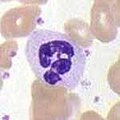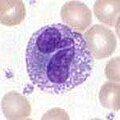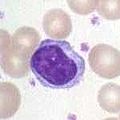White blood cell
White blood cells (a.k.a. leukocytes) are cells which form a component of the blood. They are produced in the bone marrow and help to defend the body against infectious disease and foreign materials as part of the immune system. There are normally between 4x109 and 11x109 white blood cells in a litre of healthy adult blood - about 7,000 to 25,000 white blood cells per drop. In conditions such as leukemia this may rise to as many as 50,000 white blood cells in a single drop of blood. As well as in the blood, white cells are also found in large numbers in the lymphatic system, the spleen, and in other body tissues.
Nomenclature
The name "white cells" derives from the fact that after centrifugation of a blood sample, the white cells are found in the Buffy coat, a thin layer of nucleated cells between the sedimented red blood cells and the blood plasma, which is white in color (or sometimes green, if there are large amounts of neutrophils in the sample, which are high in green myeloperoxidase).
Types
There are many different types of white blood cells. Here are the most basic kinds:
Granulocytes
Also known as Granular Leukocytes, Granulocytes are a category of white blood cells, characterised by the fact that all types have differently staining granules in their cytoplasm on light microscopy. These granules are related to lysosomes found in some regular cells and primarily act in the digestion of engulfed invaders. There are three types of granulocytes: neutrophils, basophils, and eosinophils (named according to their staining properties). Neutrophils deal with bacterial infection and are usually first responders to bacterial infection, their activity and death in large numbers forms pus. Basophils are chiefly responsible for allergic and antigen response by releasing the chemical histamine causing inflammation. Eosinophils primarily deal with parasitic infections.
Agranulocytes
Agranulocytes are a category of white blood cells characterised by the absence of granules in their cytoplasm. There are two types of agranulocytes: lymphocytes and monocytes.
Lymphocytes
Lymphocytes are much more common in the lymphatic system, and include the so-called "killer T-cells". The blood has three types of lymphocytes: B cells, T cells and natural killer cells. B cells make antibodies that bind to pathogens to enable their destruction. CD4+ (helper) T cells co-ordinate the immune response (they are what becomes defective in an HIV infection). CD8+ (cytotoxic) T cells and natural killer cells are able to kill cells of the body that are infected by a virus. T cells are crucial to the immune response because they possess a unique 'memory' system which allows them to remember past invaders and prevent disease when a similar invader is encountered again.
Monocytes
Monocytes share the "vacuum cleaner" (phagocytosis) function of neutrophils, but are much longer lived as they have an additional role: they present pieces of pathogens to T cells so that the pathogens may be recognised again and killed, or so that an antibody response may be mounted. Monocytes are also known as macrophages after they migrate from the bloodstream and enter tissue.
Diseases
- Leukopenia is a disease symptom defined as a lower than normal number of white blood cells in the blood.
- Leukocytosis refers to an increase in the number of white blood cells in the blood.
- Leukemia and lymphoma are two types of cancer in which white blood cells multiply out of control.
Other tissue cells
- Histiocytes, found in the lymphatic system and other body tissues, but not normally in blood:
- Mast cells





